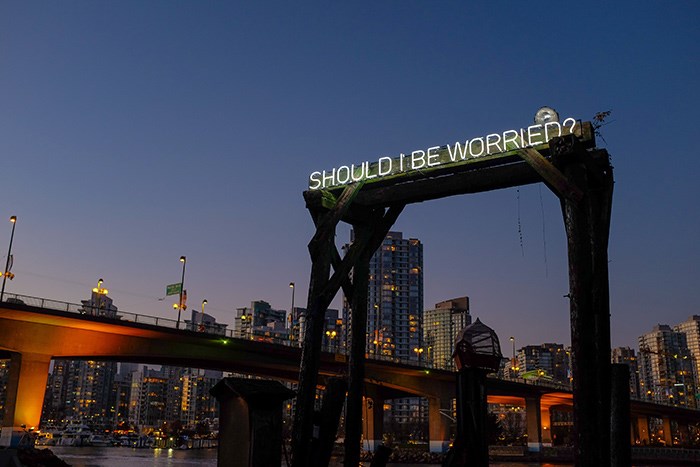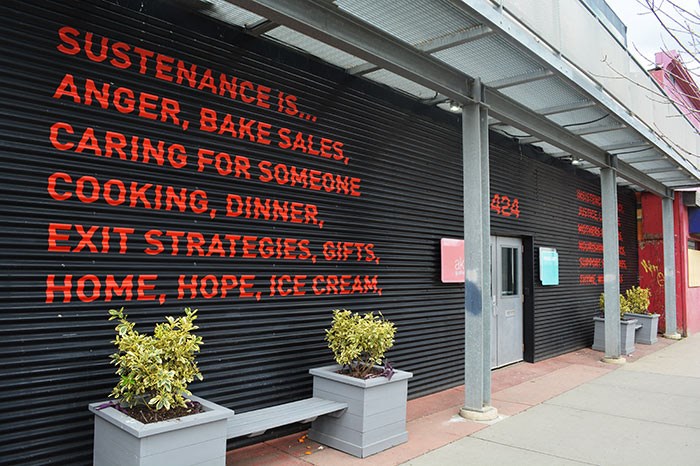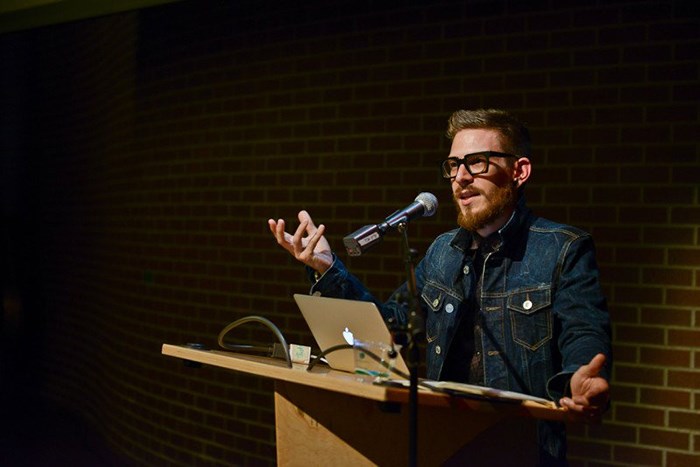 Photo/http://justinlanglois.com
Photo/http://justinlanglois.com
Earlier this month, the City of Vancouver's Sustainability Group unveiled its first collaboration with the city's Public Art Program and premiere Artist-in-Residence, Justin Langlois.
Reactions to the resulting artwork, "Should I be Worried?", have been divisive to say the least. To learn more about the new piece, we reached out to Justin directly to discuss his intentions, his process and his personal affinity for public art in B.C.
VIA: In addition to teaching at Emily Carr, you’re the city’s first “artist is residence”. What did this residency entail?
JL: The residency was based out of the Sustainability Group and spanned over 18-months beginning in July 2016. Over that time, I would sit in on a range of meetings and hear about the work that staff members were doing, while also contributing to ideas for communication and public engagement. I was able to participate in staff meetings and also host workshops on approaches to critical thinking and creative processes. In particular, I worked closely with staff addressing sea level rise communication and education for the community, which was a huge learning opportunity. In those meetings, I offered my perspective as an artist, as a citizen, and as an educator on a range of topics that the team was taking up and tried to offer some divergent thinking around how staff were approaching a particular problem or goal. And all of that helped to inform the other part of the residency, which was the creation of a new public artwork.
VIA: Can you tell us about "Should I Be Worried?"
JL: The idea behind the artwork really resulted from all the time I spent with Sustainability staff. The work they do on a daily basis has such a long-term impact, they’re creating policies that will help the city prepare for a changing climate and help our community to be more resilient. Despite hearing about all of this work and gaining a better understanding of the scale of change that’s needed to deal with climate change, I wondered, at the level of an individual, if I should be worried about these issues? What does it mean to worry about something that’s happening now but will have impacts on all future generations? Outside of a sustainability focus, I worry about so many issues in our city, from affordability issues to the criminalization of homelessness to the impacts of the opioid crisis as a public health emergency disproportionately impacting the most vulnerable members of our community. I also worry about things going on at a more personal level like, if I feel congested, should I be worried that I’m getting the flu?
VIA: Is it more important that your art is enjoyed, or that it sparks a conversation?
JL: For my own art, I’m most interested in the conversations that it can help to generate in a public setting. I think those conversations can be enjoyable, or challenging, or invigorating, but the idea of generating more dialogue in public spaces is really important to me.
 “An incomplete glossary of sustenance” at AKA artist-run, 2017
“An incomplete glossary of sustenance” at AKA artist-run, 2017
VIA: You have a history of exploring civic and social issues through public art, what draws you to these themes?
Justin Langlois: My work often explores civic engagement and critical dialogue around social issues because it’s how I think about the world around me. I think art is an interesting vehicle for tackling these ideas because of the nuances it can provide. Artwork doesn’t have to set out to ‘accomplish’ anything, it’s not necessarily tasked with solving an issue, but I think it can be particularly effective at introducing a new question or an unexpected consideration. I’m invested in that because I want to live in a community where new questions and unexpected considerations are seen as an asset and a core part of how we live together.
VIA: Why do you think public art important in Vancouver?
JL: Public art is important everywhere. In Vancouver, we’re lucky to have so many opportunities to see public art, whether it’s a temporary installation, a building-sized mural, or a permanent sculpture that becomes part of how we think about our community. I think about the things that I saw in my small town when I was growing up and how much it impacted my imagination of what public space means, what we are supposed to do (or not do) together in public, and what’s valuable as in a community setting. Public art that helps us to think about the urban environment differently or helps us to ask questions about where we are right here and right now is especially important for Vancouver, given how young the city is and how quickly the landscape is changing.
 Photo: Two Rivers Gallery Twitter
Photo: Two Rivers Gallery Twitter
VIA: What do you think of the state of art in Vancouver?
JL: There’s so much exciting work happening at so many scales, from individual artists to collectives to emerging artist-run-centres. This city has a disproportionate amount of talent as far as I’m concerned but we need to find ways to make it more viable for artists to live and work in Vancouver. I feel really lucky that I’m able to work with emerging artists at Emily Carr University of Art and Design, watching them grow over the course of their degree and then stepping into the community and doing really incredible work, I just wish more of them could afford to stay in the city.
VIA: There’s a small population that seems consistently opposed to public art in Vancouver. Do you ever wish you could address these critics? Do you ever worry that your art is misunderstood?
JL: I don’t worry if my art is misunderstood; I think there are many access points to my work and really to all of public art and that means that not everyone may understand it or be interested in it. I think, however, we would benefit from looking at public art as an investment in civic life, in future generations being more curious about where they live and more capable of living with different ideas. Public art helps us to imagine other ways to live in the world together and I think that’s worth supporting.
You can learn more about Justin Langlois HERE.


